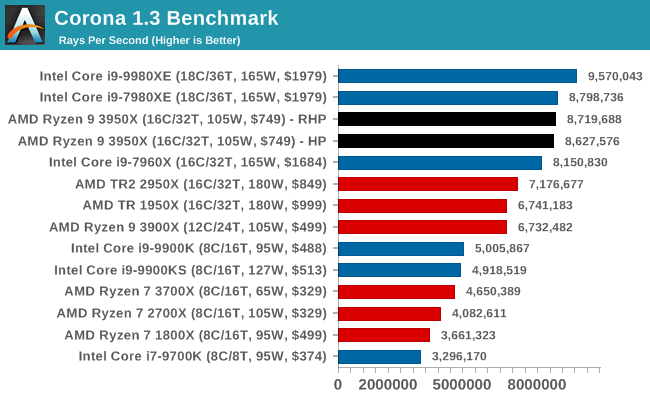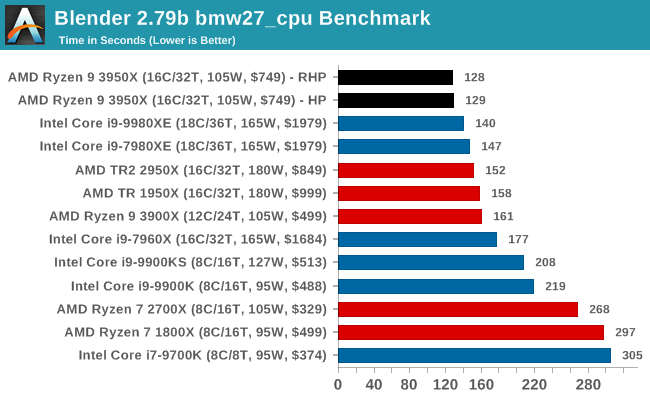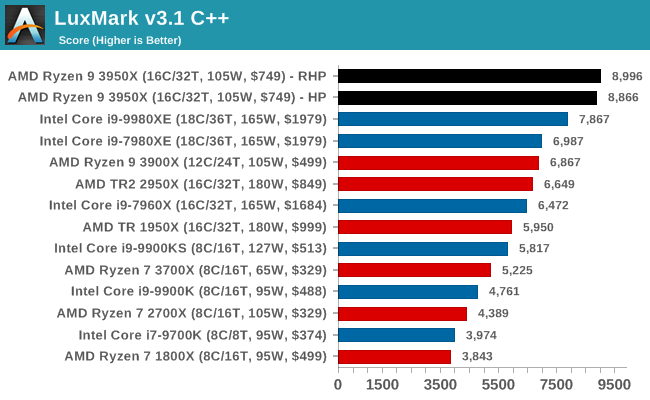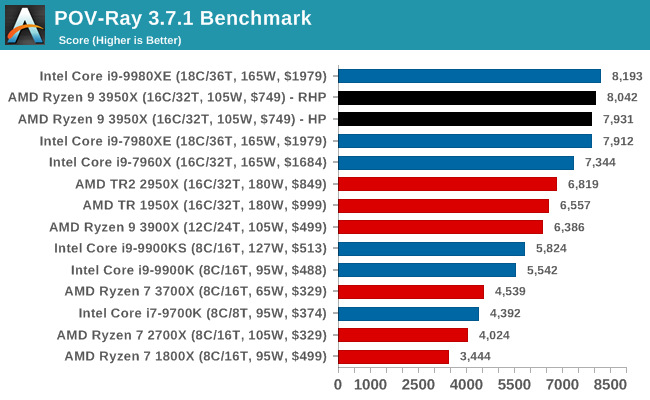The AMD Ryzen 9 3950X Review: 16 Cores on 7nm with PCIe 4.0
by Dr. Ian Cutress on November 14, 2019 9:00 AM ESTCPU Performance: Rendering Tests
Rendering is often a key target for processor workloads, lending itself to a professional environment. It comes in different formats as well, from 3D rendering through rasterization, such as games, or by ray tracing, and invokes the ability of the software to manage meshes, textures, collisions, aliasing, physics (in animations), and discarding unnecessary work. Most renderers offer CPU code paths, while a few use GPUs and select environments use FPGAs or dedicated ASICs. For big studios however, CPUs are still the hardware of choice.
All of our benchmark results can also be found in our benchmark engine, Bench.
Corona 1.3: Performance Render
An advanced performance based renderer for software such as 3ds Max and Cinema 4D, the Corona benchmark renders a generated scene as a standard under its 1.3 software version. Normally the GUI implementation of the benchmark shows the scene being built, and allows the user to upload the result as a ‘time to complete’.
We got in contact with the developer who gave us a command line version of the benchmark that does a direct output of results. Rather than reporting time, we report the average number of rays per second across six runs, as the performance scaling of a result per unit time is typically visually easier to understand.
The Corona benchmark website can be found at https://corona-renderer.com/benchmark

Intel's HEDT chips are quite good at Corona, but if we compare the 3900X to the 3950X, we still see some good scaling.
Blender 2.79b: 3D Creation Suite
A high profile rendering tool, Blender is open-source allowing for massive amounts of configurability, and is used by a number of high-profile animation studios worldwide. The organization recently released a Blender benchmark package, a couple of weeks after we had narrowed our Blender test for our new suite, however their test can take over an hour. For our results, we run one of the sub-tests in that suite through the command line - a standard ‘bmw27’ scene in CPU only mode, and measure the time to complete the render.
Blender can be downloaded at https://www.blender.org/download/

AMD is taking the lead in our blender test, with the 16-core chips easily going through Intel's latest 18-core hardware.
LuxMark v3.1: LuxRender via Different Code Paths
As stated at the top, there are many different ways to process rendering data: CPU, GPU, Accelerator, and others. On top of that, there are many frameworks and APIs in which to program, depending on how the software will be used. LuxMark, a benchmark developed using the LuxRender engine, offers several different scenes and APIs.
In our test, we run the simple ‘Ball’ scene on both the C++ code path, in CPU mode. This scene starts with a rough render and slowly improves the quality over two minutes, giving a final result in what is essentially an average ‘kilorays per second’.

Despite using Intel's Embree engine, again AMD's 16-cores easily win out against Intel's 18-core chips, at under half the cost.
POV-Ray 3.7.1: Ray Tracing
The Persistence of Vision ray tracing engine is another well-known benchmarking tool, which was in a state of relative hibernation until AMD released its Zen processors, to which suddenly both Intel and AMD were submitting code to the main branch of the open source project. For our test, we use the built-in benchmark for all-cores, called from the command line.
POV-Ray can be downloaded from http://www.povray.org/

POV-Ray ends up with AMD 16-core splitting the two Intel 18-core parts, which means we're likely to see the Intel Core i9-10980XE at the top here. It would have been interesting to see where an Intel 16-core Core-X on Cascade would end up for a direct comparison, but Intel has no new 16-core chip planned.











206 Comments
View All Comments
Spunjji - Thursday, November 14, 2019 - link
In theory it might be. In practice, they're still only able to make mobile CPUs with 4 cores or less on it.Orange_Swan - Thursday, November 14, 2019 - link
Nah, they've got at least one 6core/12thread, 15/25w mobile CPU, the Core i7-10710URetycint - Thursday, November 14, 2019 - link
That's 14nm. All Intel's 10nm processors so far have been limited to 4 core Ice Lake U processorsSmartcom5 - Friday, November 15, 2019 - link
If, and that's the whole issue here since a while now, IF Intel's 10nm would be working after all.Sure enough, that's a requirement which still needs to be fulfilled yet. The best process – no matter how oh so advanced it is going to be (on paper) – is worth exactly no·thing if it ain't working. Then, even a (on paper inferior) node is superior, since it at least meets a crucial condition; It's working (already).Thus, it isn't anymore. They relaxed it quite a bit in 2017 to make it work, that's it.
Intel's actual 10nm which spawned Ice Lake isn't the same as it was before, that's why it's coined 10nm+. It's actually less dense than Intel's initial and original-10nm which brought Cannonlake – density was toned down, it's more like ~12nm now.
Interestingly TSMC on its current 7nm N7-process already archives virtually the very same density Intel failed to archive on their initial 10nm-process back then – while their current 10nm+, which has a toned-down density from initially 2.7× down to only some 2.0—2.2× (depending on what sources you're willing to trust), is rumoured to rather equal some 12nm-ish alike process instead of being closer to any initial Intel'ian 10nm.
So while Intel somehow failed, others archived the same density-goals Intel was trying to do for years, to no greater avail – and those others where even on track as scheduled most of the time. Thus, TSMC already fabs on a process which would equal Intel's very initial 10nm-process, which never really saw any greater light of day, bar that known i3-8121U (well, and that m3-8114Y of course, ... you don't know a thing about it, okay?).
GraveNoX - Thursday, November 14, 2019 - link
Yes, they will launch 10nm and 7nm on the same day so you have the freedom to choose which version of the chip you want.Oliseo - Thursday, November 14, 2019 - link
"Based on my imagination Intel will destroy AMD"Santoval - Thursday, November 14, 2019 - link
It is meaningless to compare Intel's 7nm parts, which will be released in 2021 assuming NO delays (thus more realistically in 2022+) with AMD's current 7nm parts. If you were going for a "node for node" comparison that is even more meaningless, because Intel's 7nm node will be equivalent to TSMC's 4nm or 5nm node in transistor density (I have read numbers predicting ~185 million transistors per mm^2 for TSMC's 5nm node and ~200nm MTr/mm^2 for Intel's 7nm node). TSMC's 5nm node will almost certainly be released before Intel's 7nm node by the way.Regarding Intel's 10nm node parts, while Sunny Cove appears to have a higher IPC than Zen 2 Intel's 10nm parts suffer from much lower clocks which have eaten away all or almost all the IPC gains. This is why Intel have not announced an Ice Lake-S/H release and intend to replace it with Comet Lake-S/H. S/H parts require high clocks, which cannot be provided by Intel's 10nm+ node due to very low yields at high clocks. Only low power Ice Lake-U/Y parts and Ice Lake Xeons will be released. Why? Because these parts have lower clocks.
More or less the same thing might be repeated with Tiger Lake, in 2H 2020, which would mean that Intel are not very confident of fixing their 10nm node issues even with their 10nm++ node variant. It is rumored that there will be no Tiger Lake-S/H parts and Rocket Lake-S/H will take their place. What's Rocket Lake? A 14nm+++++++ part but with a new μarch (Sunny or Willow Cove cores and a Gen11 or Gen12 iGPU).
Santoval - Thursday, November 14, 2019 - link
edit : "and ~200 MTr/mm^2 for Intel's 7nm node".Targon - Thursday, November 14, 2019 - link
Didn't TSMC start 5nm risk production a month or so ago?John_M - Monday, November 25, 2019 - link
Yes, they did.